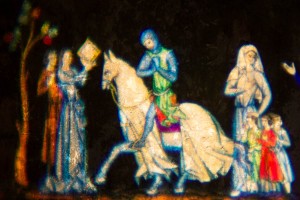Traces of Medieval Europe lurk in the Ottoman alleyways
Acre – Israel, and much of the wider Levant, is saturated in history. Kick some dust away and you could find yourself standing on ancient cobblestones, or discovering contemporary truisms turned upside-down.
Whereas the term Caliphate now symbolizes death and destruction, it once stood for progress and enlightenment.
No place is better situated to display the paradox of history than Acre, the 5300-year-old port city that was a strategic plum through the ages and served as the one-time capital of the Crusader Kingdom.
A natural harbour with open water on three sides, Acre provides breathtaking views and invaluable sea access to whomever controls it. Numerous ancient cultures flourished and collided along the Mediterranean trade route and Acre’s location at the eastern edge of the Mediterranean provided a key link for commerce between Europe and what became known as the Far East.
Most crucially, Acre was a medieval hub transmitting culture, ideas and technologies into Europe from the more developed East.
Acre, known as Akko, in Hebrew and as Akka, in Arabic, is mentioned in ancient Egyptian and Akkadian writing as far back as 2000 BCE.
Acre was ruled by Canaanites, Phoenicians, Israelites, Greeks, Romans, and finally by Muslims and was under Islamic control until early medieval Crusaders, who believed that the Holy City of Jerusalem was threatened by Muslim hordes, made it the objective of four consecutive, and ultimately successful, Crusades. From 1104 to 1291 Acre was a Crusader city known as St. John d’Acre in honor of John the Baptist, the patron saint of the Knights Hospitallers who established their headquarters there. To this day, the city is known in French as Saint-Jean d’Acre.
Depiction of Medieval art at the Akko, Ottoman-Crusader Route, in Acre’s old city. (Photograph: Robert Swift/The Media Line)
The Hospitallers were one of several knightly orders to emerge during the years of the Crusades and much of what remains of Acre’s old city was built by the order. Hospitallers were known for running hospitals and orphanages and for protecting sick and injured Christian pilgrims on their way to Jerusalem. A militant fraternity, as well as a charitable organization, its warriors were identified by a white cross on a black background. They are not to be confused with the Knights Templar—a separate order wearing red crosses on white fields— who also established a presence in Acre.
The Islamic State– ISIS– doesn’t have much on the Crusaders. When the first Crusade captured Jerusalem in 1099, the city’s Muslim inhabitants were massacred, as were the Jews and many Christians, now subject to Dark Age edicts imported from Europe.
But in addition to violence and religious fanaticism, Crusaders provided a form of early cultural interaction.
Many cultural currencies made their way to Christendom through ports like Acre. Notions of hygiene, practiced by the ancient Greeks and Romans, but abandoned by Europe in the Dark Ages spread across the sea, as were architectural aesthetics and the use of heavy stone and loadbearing arches. Near Eastern sophistication led to a change in the way European fortifications were built, spearheading a shift from timber to stone.
Medicine also flourished. “In the tenth and eleventh century Europe, medicine was classical Greek medicine that was stuck or had even declined for a few hundred years,” Professor Efraim Lev, Chairman of the Department of Land of Israel Studies at the University of Haifa, told The Media Line.
“On the other side this Hippocratic medicine was transferred [from the ancient Greeks] to the Muslims by translating books, and the Arabs improved on it.” The Crusades acted as a principle route for this knowledge, Lev explained, not only in medicine but in other fields of scientific endeavor.
As well as medical knowledge, materials and ingredients traveled west. By this point the Muslim Caliphate had expanded east as far as India, Sri Lanka and Persia and brought with it new and previously unknown goods.
This trade from the East helped make Acre so valuable then and remain an unparalleled window into Medieval times even today. Knightly orders like the Hospitallers and the Templars became rich and powerful—and the envy of royalty back in Europe.
Acre is keen to show off its fascinating Crusader history. The city was recognized as a World Heritage Site by the United Nations Educational, Scientific and Cultural Organization (UNESCO) in 2001.
“The crusades have defined Arab and Western relations, especially in the consciousness of the Arab world,” Martin Hoch, a historian of the Crusader States with the Konrad Adenauer Foundation, told The Media Line. While other historical events have eclipsed the Crusades in the consciousness of the West, the historian emphasized that this is not the case with the Arab Muslim world.
When referring to its enemies, ISIS uses the word ‘Salibi,’ crusader, Hoch said. “The very fact that ISIS labels every opponent ‘Crusader’, including Jordanian or Arab forces deployed against them, that is the cultural legacy (of the Crusades).”
